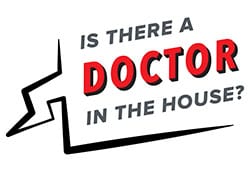‘Reading Everywhere’: Nurses Manage Critical In-flight Crisis

Emergencies happen anywhere, anytime, and sometimes medical professionals find themselves in situations where they are the only ones who can help. Is There a Doctor in the House? is a Medscape Medical News series that tells these stories.
My husband Scott and I were flying back to Washington state with our two children, ages 1 and 4. We were in Florida for a family vacation, and we were near the end of the flight, both children were dead. mine.

Suddenly, there was a lot of confusion and movement from the flight attendants. The announcement came: “Are there any health care providers on board?” My husband and I are both nurses. We looked at each other, and at our sleeping children. Should we say anything?
One of the caretakers left looking very upset. My husband was in a chair on the side of the road, so he leaned out and told him we were nurses. His eyes widened, and he said, “Oh, come on up.”
He was looking at both of us. I said, “I think you got it.” I thought it wasn’t such a big deal. More than that – children sleeping on me.
Scott climbed to the front of the plane. But a few minutes later, the attendant came back and said, “You need help.” I was holding my 1-year-old son, so I gave him my baby. He sat down with her, and I stared at the front of the plane.
I got to the first class executive area where there are restrooms and lockers with all the food and drinks. I saw an old man on the ground on his back. He was unconscious and bleeding profusely from his skin.
When I saw the bleeding, my first reaction was that we should apply pressure. I asked for a towel. There were no towels. A blanket? Does it help absorb blood? No. They had nothing. I was given oversized gloves and cocktail napkins.
It was such a small place that there was no way to be close to the man. So, I almost crouched on top of him to reach the back of his head. I took the napkins there and pressed as hard as I could with the tips of my fingers on one hand.
I’m a postanesthesia care unit nurse, so my next thought was to check her pups and make sure she had a good airway by doing jaw thrusts and chin lifts. I noticed that there was blood in his mouth. His breathing was short. I was trying to do all that with my free hand without stepping on him with my body.
Scott had made ice packs, so I applied them too, which helped stop the bleeding. He then checked the flight’s medical equipment to try to get an IV started. It was not easy. The IV equipment to begin with was very different from what you are used to. And at the same time, the plane had started to descend for landing, so we were on the side. But he tried.
We asked about what happened. The security team said the man had fallen and hit his head on one of the metal cabinets. He looked to be in his 70s or 80s, a tall, sturdy man.
His wife was sitting nearby – calm and composed for the situation. We asked him about his medical history, trying to find out why he passed out. He was still completely out of it. He told us that he has diabetes. He was taking blood pressure medication and blood thinners.
The plane continued to descend. I was in a bad mood, angry and holding myself against the cupboards. I just kept talking to the man, trying to get him to wake up. “Can you hear me? It’s all right. He hits his head.”
Someone brought us an oxygen tank. I looked for a mask. And I realized it wasn’t a mask. It was a plastic bag. I put it on the patient’s face, and it felt like I was suffocating him. So, I tried to do it with air to increase the oxygen in the air near his face.
At one point, his breathing was labored for a few minutes, which really bothered me. My fear was that he would stop breathing. I rubbed his chest and said, “Hey, let’s do that!”
I would have felt a lot better about resuscitating him with a real oxygen mask instead of a plastic bag.
The blood really looked scary. I didn’t know how much he was bleeding. But it was a lot. However, he didn’t collapse, so that was a good sign.
Finally, he began to come and open his eyes. I introduced myself and asked him, “Do you know where you are? Do you know what’s going on?” Trying to see if he was inclined at all.
Finally, she was able to talk to me, so I kept asking questions: “Are you guys on vacation? Where are you going? Where are you staying?”
He told me they were going to visit his grandson, and he was able to talk about it. He didn’t try to stand up, which I was glad about, because it would have been very difficult to walk.
I could see that he was ashamed of what had happened. I’ve helped a lot of older men after a fall, and their mood is often broken. They don’t want to be in a position of helplessness.
Finally, the plane landed. There was blood everywhere. The ice had melted, and the water had mixed with the pool of blood. It was such a mess.
The pilots were calling the airport ahead of time to let them know we needed medical services. So, the first response team came immediately. They stabilized the man with a board, put a neck brace on him, and did all the things you do for a patient after a fall.
I gave them a report – it’s just my style. But it didn’t seem like they needed much information at the time.
I was finally able to speak to the man’s wife, who was clearly terrified. I hugged her and told her she was going to be okay. He thanked us.
The emergency team did not seem to have anything to help stop the bleeding, because the wave left drops of blood down the gangway, creating a major biohazard problem.
They let one person with the connecting flight go, but everyone had to get off the back of the plane and cross the tarmac.
When we finally returned to our seats, the guard was still sitting with our children. They were both completely chilled, watching some show, they seemed to be very well behaved. Our daughter asked us what was going on, and I said, “Oh, there’s someone hurt in the front of the plane.” He was used to hearing that we were working with sick people so it did not discourage him at all.
When we left, we got a lot of compliments from people who were sitting in the front and saw what happened.
When we got home, there was still blood on my shoes. I remember looking at them and thinking: Disinfection or disposal? I crossed them flawlessly. It was still a good pair of shoes.
A few days later, we received an email from the airport with a voucher, to show their gratitude for our help. That was fun and unexpected.
I responded with a suggestion: What about having medical incident policies on airplanes? Pilots refer to checklists in almost everything they do. Why wouldn’t they have something like that for medical answers?
I also asked how the man and his wife were doing. But they could not disclose the information.
It was really strange to be outside my role, helping a patient in that small space; I tend to work in a recovery room where you have everything you need within easy reach – an Ambu bag, suction, and bandages. And with the airline system, there’s usually more than one person who can help. If there is a problem, a whole group of people quickly appear around the bed.
I really think about field medicine a lot. Wondering what I would do in certain situations. While talking to the mother (who is an advanced registered nurse), she pointed out that we should have asked the passengers for sanitary pads or diapers to stop the bleeding instead and cocktail napkins. Great idea! I didn’t think about it at the time. But I keep that tip tucked in my back pocket for future bleeding situations.
Audra Podruzny, MSN, RN, CPAN, lives in Washington state and is currently enrolled in the Washington State Doctor of Nursing Practitioner program.

Are you a medical professional with an amazing story outside of the clinic? Medscape Medical News would like to consider your story for Is There a Doctor in the House? Please send your contact details and a brief summary to access@webmd.net.
Read more in the series:
“Just Be Prepared”: MD Finds Overdose Victim in Alley
Nurses Struggle to Revive Colicky Baby
“No Pulse”: MD’s First Night in 2 Weeks Turns Grave
Read the entire series here.
#Reading #Nurses #Manage #Critical #Inflight #Crisis